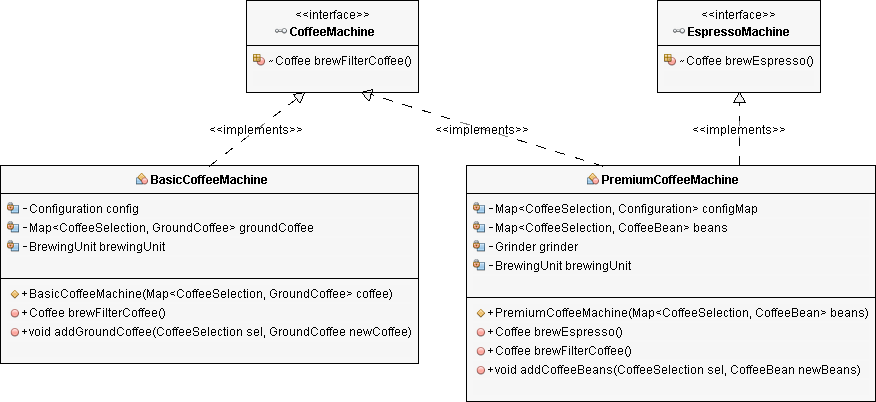
By TechnologyAzure and AWS Monitoring
By IndustryIntegrates with your stack
By InitiativeEngineering & DevOps Teams
TechnicalIt’s easy to get the help you need

The SOLID design principles were promoted by Robert C. Martin and are some of the best-known design principles in object-oriented software development. SOLID is a mnemonic acronym for the following five principles:
Each of these principles can stand on its own and has the goal to improve the robustness and maintainability of object-oriented applications and software components. But they also add to each other so that applying all of them makes the implementation of each principle easier and more effective.
I explained the first four design principles in previous articles. In this one, I will focus on the Dependency Inversion Principle. It is based on the Open/Closed Principle and the Liskov Substitution Principle. You should, therefore, at least be familiar with these two principles, before you read this article.

The general idea of this principle is as simple as it is important: High-level modules, which provide complex logic, should be easily reusable and unaffected by changes in low-level modules, which provide utility features. To achieve that, you need to introduce an abstraction that decouples the high-level and low-level modules from each other.
Based on this idea, Robert C. Martin’s definition of the Dependency Inversion Principle consists of two parts:
An important detail of this definition is, that high-level and low-level modules depend on the abstraction. The design principle does not just change the direction of the dependency, as you might have expected when you read its name for the first time. It splits the dependency between the high-level and low-level modules by introducing an abstraction between them. So in the end, you get two dependencies:
This might sound more complex than it often is. If you consequently apply the Open/Closed Principle and the Liskov Substitution Principle to your code, it will also follow the Dependency Inversion Principle.
The Open/Closed Principle required a software component to be open for extension, but closed for modification. You can achieve that by introducing interfaces for which you can provide different implementations. The interface itself is closed for modification, and you can easily extend it by providing a new interface implementation.
Your implementations should follow the Liskov Substitution Principle so that you can replace them with other implementations of the same interface without breaking your application.
Let’s take a look at the CoffeeMachine project in which I will apply all three of these design principles.
You can buy lots of different coffee machines. Rather simple ones that use water and ground coffee to brew filter coffee, and premium ones that include a grinder to freshly grind the required amount of coffee beans and which you can use to brew different kinds of coffee.
If you build a coffee machine application that automatically brews you a fresh cup of coffee in the morning, you can model these machines as a BasicCoffeeMachine and a PremiumCoffeeMachine class.

The implementation of the BasicCoffeeMachine is quite simple. It only implements a constructor and two public methods. You can call the addGroundCoffee method to refill ground coffee, and the brewFilterCoffee method to brew a cup of filter coffee.
import java.util.Map;
public class BasicCoffeeMachine implements CoffeeMachine {
private Configuration config;
private Map<CoffeeSelection, GroundCoffee> groundCoffee;
private BrewingUnit brewingUnit;
public BasicCoffeeMachine(Map<CoffeeSelection, GroundCoffee> coffee).
this.groundCoffee = coffee;
this.brewingUnit = new BrewingUnit();
this.config = new Configuration(30, 480);
}
@Override
public Coffee brewFilterCoffee() {
// get the coffee
GroundCoffee groundCoffee = this.groundCoffee.get(CoffeeSelection.FILTER_COFFEE);
// brew a filter coffee
return this.brewingUnit.brew(CoffeeSelection.FILTER_COFFEE, groundCoffee, this.config.getQuantityWater());
}
public void addGroundCoffee(CoffeeSelection sel, GroundCoffee newCoffee) throws CoffeeException {
GroundCoffee existingCoffee = this.groundCoffee.get(sel);
if (existingCoffee != null) {
if (existingCoffee.getName().equals(newCoffee.getName())) {
existingCoffee.setQuantity(existingCoffee.getQuantity() + newCoffee.getQuantity())
} else {
throw new CoffeeException("Only one kind of coffee supported for each CoffeeSelection.")
}
} else {
this.groundCoffee.put(sel, newCoffee)
}
}
}
The implementation of the PremiumCoffeeMachine class looks very similar. The main differences are:
The brewFilterCoffee method is identical to the one provided by the BasicCoffeeMachine.
import java.util.HashMap;
import java.util.Map;
public class PremiumCoffeeMachine {
private Map<CoffeeSelection, Configuration> configMap;
private Map<CoffeeSelection, CoffeeBean> beans;
private Grinder grinder
private BrewingUnit brewingUnit;
public PremiumCoffeeMachine(Map<CoffeeSelection, CoffeeBean> beans) {
this.beans = beans;
this.grinder = new Grinder();
this.brewingUnit = new BrewingUnit();
this.configMap = new HashMap<>();
this.configMap.put(CoffeeSelection.FILTER_COFFEE, new Configuration(30, 480));
this.configMap.put(CoffeeSelection.ESPRESSO, new Configuration(8, 28));
}
public Coffee brewEspresso() {
Configuration config = configMap.get(CoffeeSelection.ESPRESSO);
// grind the coffee beans
GroundCoffee groundCoffee = this.grinder.grind(
this.beans.get(CoffeeSelection.ESPRESSO),
config.getQuantityCoffee())
// brew an espresso
return this.brewingUnit.brew(CoffeeSelection.ESPRESSO, groundCoffee,
config.getQuantityWater());
}
public Coffee brewFilterCoffee() {
Configuration config = configMap.get(CoffeeSelection.FILTER_COFFEE);
// grind the coffee beans
GroundCoffee groundCoffee = this.grinder.grind(
this.beans.get(CoffeeSelection.FILTER_COFFEE),
config.getQuantityCoffee());
// brew a filter coffee
return this.brewingUnit.brew(CoffeeSelection.FILTER_COFFEE, groundCoffee,
config.getQuantityWater());
}
public void addCoffeeBeans(CoffeeSelection sel, CoffeeBean newBeans) throws CoffeeException {
CoffeeBean existingBeans = this.beans.get(sel);
if (existingBeans != null) {
if (existingBeans.getName().equals(newBeans.getName())) {
existingBeans.setQuantity(existingBeans.getQuantity() + newBeans.getQuantity());
} else {
throw new CoffeeException("Only one kind of coffee supported for each CoffeeSelection.");
}
} else {
this.beans.put(sel, newBeans);
}
}
}
To implement a class that follows the Dependency Inversion Principle and can use the BasicCoffeeMachine or the PremiumCoffeeMachine class to brew a cup of coffee, you need to apply the Open/Closed and the Liskov Substitution Principle. That requires a small refactoring during which you introduce interface abstractions for both classes.
The main task of both coffee machine classes is to brew coffee. But they enable you to brew different kinds of coffee. If you use a BasicCoffeeMachine, you can only brew filter coffee, but with a PremiumCoffeeMachine, you can brew filter coffee or espresso. So, which interface abstraction would be a good fit for both classes?
As all coffee lovers will agree, there are huge differences between filter coffee and espresso. That’s why we are using different machines to brew them, even so, some machines can do both. I, therefore, suggest to create two independent abstractions:
As you can see in the following code snippets, the definition of both interface is pretty simple.
public interface CoffeeMachine {
Coffee brewFilterCoffee();
}
public interface EspressoMachine {
Coffee brewEspresso();
}
In the next step, you need to refactor both coffee machine classes so that they implement one or both of these interfaces.
Let’s start with the BasicCoffeeMachine class. You can use it to brew a filter coffee, so it should implement the CoffeeMachine interface. The class already implements the brewFilterCoffee() method. You only need to add implements CoffeeMachine to the class definition.
public class BasicCoffeeMachine implements CoffeeMachine {
private Configuration config;
private Map<CoffeeSelection, GroundCoffee> groundCoffee;
private BrewingUnit brewingUnit;
public BasicCoffeeMachine(Map<CoffeeSelection, GroundCoffee> coffee) {
this.groundCoffee = coffee;
this.brewingUnit = new BrewingUnit();
this.config = new Configuration(30, 480);
}
@Override
public Coffee brewFilterCoffee() {
// get the coffee
GroundCoffee groundCoffee = this.groundCoffee.get(CoffeeSelection.FILTER_COFFEE);
// brew a filter coffee
return this.brewingUnit.brew(CoffeeSelection.FILTER_COFFEE, groundCoffee, this.config.getQuantityWater());
}
public void addGroundCoffee(CoffeeSelection sel, GroundCoffee newCoffee) throws CoffeeException {
GroundCoffee existingCoffee = this.groundCoffee.get(sel);
if (existingCoffee != null) {
if (existingCoffee.getName().equals(newCoffee.getName())) {
existingCoffee.setQuantity(existingCoffee.getQuantity() + newCoffee.getQuantity());
} else {
throw new CoffeeException("Only one kind of coffee supported for each CoffeeSelection.");
}
} else {
this.groundCoffee.put(sel, newCoffee);
}
}
}
The refactoring of the PremiumCoffeeMachine also doesn’t require a lot of work. You can use the coffee machine to brew filter coffee and espresso, so the PremiumCoffeeMachine class should implement the CoffeeMachine and the EspressoMachine interfaces. The class already implements the methods defined by both interfaces. You just need to declare that it implements the interfaces.
import java.util.HashMap;
import java.util.Map;
public class PremiumCoffeeMachine implements CoffeeMachine, EspressoMachine {
private Map<CoffeeSelection, Configuration> configMap;
private Map<CoffeeSelection, CoffeeBean> beans;
private Grinder grinder;
private BrewingUnit brewingUnit;
public PremiumCoffeeMachine(Map<CoffeeSelection, CoffeeBean> beans) {
this.beans = beans;
this.grinder = new Grinder();
this.brewingUnit = new BrewingUnit();
this.configMap = new HashMap<>();
this.configMap.put(CoffeeSelection.FILTER_COFFEE, new Configuration(30, 480));
this.configMap.put(CoffeeSelection.ESPRESSO, new Configuration(8, 28));
}
@Override
public Coffee brewEspresso() {
Configuration config = configMap.get(CoffeeSelection.ESPRESSO);
// grind the coffee beans
GroundCoffee groundCoffee = this.grinder.grind(
this.beans.get(CoffeeSelection.ESPRESSO),
config.getQuantityCoffee());
// brew an espresso
return this.brewingUnit.brew(CoffeeSelection.ESPRESSO, groundCoffee,
config.getQuantityWater());
}
@Override
public Coffee brewFilterCoffee() {
Configuration config = configMap.get(CoffeeSelection.FILTER_COFFEE);
// grind the coffee beans
GroundCoffee groundCoffee = this.grinder.grind(
this.beans.get(CoffeeSelection.FILTER_COFFEE),
config.getQuantityCoffee());
// brew a filter coffee
return this.brewingUnit.brew(CoffeeSelection.FILTER_COFFEE,
groundCoffee,config.getQuantityWater());
}
public void addCoffeeBeans(CoffeeSelection sel, CoffeeBean newBeans) throws CoffeeException {
CoffeeBean existingBeans = this.beans.get(sel);
if (existingBeans != null) {
if (existingBeans.getName().equals(newBeans.getName())) {
existingBeans.setQuantity(existingBeans.getQuantity() + newBeans.getQuantity());
} else {
throw new CoffeeException("Only one kind of coffee supported for each CoffeeSelection.");
}
} else {
this.beans.put(sel, newBeans);
}
}
}
The BasicCoffeeMachine and the PremiumCoffeeMachine classes now follow the Open/Closed and the Liskov Substitution principles. The interfaces enable you to add new functionality without changing any existing code by adding new interface implementations. And by splitting the interfaces into CoffeeMachine and EspressoMachine, you separate the two kinds of coffee machines and ensure that all CoffeeMachine and EspressMachine implementations are interchangeable.

You can now create additional, higher-level classes that use one or both of these interfaces to manage coffee machines without directly depending on any specific coffee machine implementation.
As you can see in the following code snippet, due to the abstraction of the CoffeeMachine interface and its provided functionality, the implementation of the CoffeeApp is very simple. It requires a CoffeeMachine object as a constructor parameter and uses it in the prepareCoffee method to brew a cup of filter coffee.
public class CoffeeApp {
public class CoffeeApp {
private CoffeeMachine coffeeMachine;
public CoffeeApp(CoffeeMachine coffeeMachine) {
this.coffeeMachine = coffeeMachine
}
public Coffee prepareCoffee() throws CoffeeException {
Coffee coffee = this.coffeeMachine.brewFilterCoffee();
System.out.println("Coffee is ready!");
return coffee;
}
}
The only code that directly depends on one of the implementation classes is the CoffeeAppStarter class, which instantiates a CoffeeApp object and provides an implementation of the CoffeeMachine interface. You could avoid this compile-time dependency entirely by using a dependency injection framework, like Spring or CDI, to resolve the dependency at runtime.
import java.util.HashMap;
import java.util.Map;
public class CoffeeAppStarter {
public static void main(String[] args) {
// create a Map of available coffee beans
Map<CoffeeSelection, CoffeeBean> beans = new HashMap<CoffeeSelection, CoffeeBean>();
beans.put(CoffeeSelection.ESPRESSO, new CoffeeBean(
"My favorite espresso bean", 1000));
beans.put(CoffeeSelection.FILTER_COFFEE, new CoffeeBean(
"My favorite filter coffee bean", 1000))
// get a new CoffeeMachine object
PremiumCoffeeMachine machine = new PremiumCoffeeMachine(beans);
// Instantiate CoffeeApp
CoffeeApp app = new CoffeeApp(machine);
// brew a fresh coffee
try {
app.prepareCoffee();
} catch (CoffeeException e) {
e.printStackTrace();
}
}
}
Throughout this post, we have delved into the concepts of Dependency Inversion and how it comes in handy when tackling tightly coupled software development. Dependency Injection also has the same objective. However, they both employ different techniques. The crux of Dependency Inversion lies in reversing dependencies by enabling higher-level modules to establish abstractions and lower-level modules to implement them. Conversely, Dependency Injection entails supplying dependent objects with essential dependencies from an external source, commonly via constructors or setters.
Embracing Dependency Inversion enables the construction of loosely coupled components—leading to simpler testing and replacement of modules without causing disruptions to the entire system. Furthermore, this approach fosters the utilization of SOLID principles, ultimately leading to a more refined and sustainable codebase.

The Dependency Inversion Principle is the fifth and final design principle that we discussed in this series. It introduces an interface abstraction between higher-level and lower-level software components to remove the dependencies between them.
As you have seen in the example project, you only need to consequently apply the Open/Closed and the Liskov Substitution principles to your code base. After you have done that, your classes also comply with the Dependency Inversion Principle. This enables you to change higher-level and lower-level components without affecting any other classes, as long as you don’t change any interface abstractions.
If you enjoyed this article, you should also read my other articles about the SOLID design principles:
With APM, server health metrics, and error log integration, improve your application performance with Stackify Retrace. Try your free two week trial today
Stackify's APM tools are used by thousands of .NET, Java, PHP, Node.js, Python, & Ruby developers all over the world.
Explore Retrace's product features to learn more.
If you would like to be a guest contributor to the Stackify blog please reach out to stackify@stackify.com